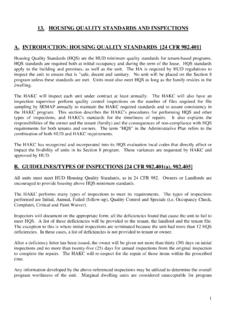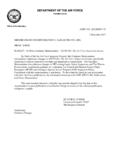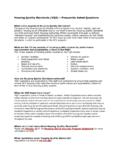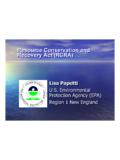Transcription of Iran’s Nuclear Program: Status - Federation of American ...
1 Iran's Nuclear Program: Status Updated May 10, 2019. Congressional Research Service RL34544. Iran's Nuclear Program: Status Summary Iran's Nuclear program began during the 1950s. The United States has expressed concern since the mid-1970s that Tehran might develop Nuclear weapons. Iran's construction of gas centrifuge uranium enrichment facilities is currently the main source of proliferation concern. Gas centrifuges can produce both low-enriched uranium (LEU), which can be used in Nuclear power reactors, and weapons-grade highly enriched uranium (HEU), which is one of the two types of fissile material used in Nuclear weapons. Is Iran Capable of Building Nuclear Weapons? The United States has assessed that Tehran possesses the technological and industrial capacity to produce Nuclear weapons. But Iran has not yet mastered all of the necessary technologies for building such weapons. Whether Iran has a viable design for a Nuclear weapon is unclear. A. National Intelligence Estimate made public in 2007 assessed that Tehran halted its Nuclear weapons program in 2003.
2 The estimate, however, also assessed that Tehran is keeping open the option to develop Nuclear weapons and that any decision to end a Nuclear weapons program is inherently reversible. intelligence officials have reaffirmed this judgment on several occasions. Obtaining fissile material is widely regarded as the most difficult task in building Nuclear weapons. As of January 2014, Iran had produced an amount of LEU containing up to 5%. uranium-235, which, if further enriched, could theoretically have produced enough HEU for as many as eight Nuclear weapons. Iran had also produced LEU containing nearly 20% uranium- 235; the total amount of this LEU, if it had been in the form of uranium hexafluoride and further enriched, would have been sufficient for a Nuclear After the Joint Plan of Action, which Tehran concluded with China, France, Germany, Russia, the United Kingdom, and the United States (collectively known as the P5+1 ), went into effect in January 2014, Iran either converted much of its LEU containing nearly 20% uranium-235 for use as fuel in a research reactor located in Tehran, or prepared it for that purpose.
3 Iran has diluted the rest of that stockpile so that it contained no more than 5% uranium-235. In addition, Tehran has implemented various restrictions on, and provided the IAEA with additional information about, its Nuclear program pursuant to the July 2015 Joint Comprehensive Plan of Action (JCPOA), which Tehran concluded with the P5+1. Although Iran claims that its Nuclear program is exclusively for peaceful purposes, the program has generated considerable concern that Tehran is pursuing a Nuclear weapons program. The Security Council responded to Iran's refusal to suspend work on its uranium enrichment program by adopting several resolutions that imposed sanctions on Tehran. Despite evidence that sanctions and other forms of pressure have slowed the program, Iran continued to enrich uranium, install additional centrifuges, and conduct research on new types of centrifuges. Tehran has also worked on a heavy-water reactor, which was a proliferation concern because its spent fuel would have contained plutonium the other type of fissile material used in Nuclear weapons.
4 However, plutonium must be separated from spent fuel a procedure called reprocessing. Iran has said that it will not engage in reprocessing. Who Is Monitoring Iran's Nuclear Program? The International Atomic Energy Agency (IAEA) monitors Iran's Nuclear facilities and has verified that Tehran's declared Nuclear facilities and materials have not been diverted for military purposes. The agency has also verified that Iran's compliance with the JCPOA. On the JCPOA's Implementation Day, which took place on January 16, 2016, all of the previous Security Council resolutions' requirements were terminated. The Nuclear Nonproliferation Treaty (NPT) and Congressional Research Service Iran's Nuclear Program: Status Security Council Resolution 2231, which the council adopted on July 20, 2015, compose the current legal framework governing Iran's Nuclear program. Iran has continued to comply with the JCPOA and Resolution 2231. Iran and the IAEA agreed in 2007 on a work plan to clarify outstanding questions regarding Tehran's Nuclear program, most of which concerned possible Iranian procurement activities and research directly applicable to Nuclear weapons development.
5 A December 2015 report to the IAEA Board of Governors from agency Director-General Yukiya Amano contains the IAEA's final assessment on the resolution of these outstanding issues. How Soon Could Iran Produce a Nuclear Weapon? Then-Under Secretary of State for Political Affairs Wendy Sherman explained during an October 2013 hearing of the Senate Committee on Foreign Relations that Iran would need as much as one year to produce a Nuclear weapon if the government decided to do so. At the time, Tehran would have needed two to three months to produce enough weapons-grade HEU for a Nuclear weapon. Iran's compliance with the JCPOA has increased that time frame to one year, according to officials. These estimates apparently assume that Iran would use its declared Nuclear facilities to produce fissile material for a weapon. However, Tehran would probably use covert facilities for this purpose; Iranian efforts to produce fissile material for Nuclear weapons by using its known Nuclear facilities would almost certainly be detected by the IAEA.
6 Congressional Research Service Iran's Nuclear Program: Status Contents Background .. 1. Proliferation Concerns .. 1. Scope and Purpose of Iran's Nuclear Program .. 3. Recent Nuclear 6. Iran's Cooperation with the IAEA .. 11. Possible Military Dimensions .. 11. Other IAEA Cooperation 14. Status of Iran's Nuclear Facilities .. 17. Uranium Enrichment Facilities .. 18. Natanz Commercial Facility .. 19. Natanz Pilot Facility .. 20. Fordow Enrichment Facility .. 21. Enriched Uranium Containing Up To 20% Uranium-235 .. 23. Future Centrifuge Facilities .. 24. Inconsistent Progress .. 25. Uranium Conversion .. 26. Plutonium .. 27. Arak Reactor and Redesign .. 27. Bushehr Reactor .. 30. Possible Future Reactors .. 31. Fuel Manufacturing Facilities .. 31. Uranium Mines and Mills .. 31. Effects of Sanctions and Sabotage on Iran's Enrichment Program .. 32. Sanctions .. 32. Sabotage .. 34. Nuclear Weapon Development Capabilities .. 35. Timelines .. 38. Declared Versus Undeclared Nuclear Facilities.
7 40. Does Iran Have a Nuclear Weapons Program? .. 41. Government Estimates .. 44. Living with 47. Other Constraints on Nuclear Weapons Ambitions .. 47. Appendixes Appendix A. Iranian Statements on Nuclear Weapons .. 50. Appendix B. Organization of Iran's Nuclear Program .. 51. Appendix C. Multilateral Diplomacy Concerning Iran's Nuclear Program .. 55. Appendix D. Trump Administration Joint Cooperative Plan of Action Policy .. 65. Appendix E. Possible Military Dimensions of Iran's Nuclear Program .. 68. Appendix F. Iranian Centrifuge Workshops and Related Entities .. 71. Appendix G. Post-2003 Suppliers to Iran's Uranium Enrichment Program .. 75. Congressional Research Service Iran's Nuclear Program: Status Contacts Author 78. Congressional Research Service Iran's Nuclear Program: Status Background Iran's Nuclear program began during the 1950s. Construction of a research reactor, called the Tehran Research Reactor (TRR), located in Tehran began in 1960; the reactor went critical in During the 1970s, Tehran pursued an ambitious Nuclear power program.
8 According to contemporaneous documents, Iran wanted to construct 10-20 Nuclear power reactors and produce more than 20,000 megawatts of Nuclear power by Iran also began constructing a light-water Nuclear power reactor near the city of Bushehr, and it considered obtaining uranium enrichment and reprocessing technology. Proliferation Concerns Iran took steps to demonstrate that it was not pursuing Nuclear weapons. For example, Tehran signed the Nuclear Nonproliferation Treaty (NPT) in 1968 and ratified it in 1970. Iran also submitted a draft resolution to the General Assembly in 1974 that called for establishing a Nuclear -weapons-free zone in the Middle East. Nevertheless, mid-1970s intelligence reports expressed concern that Iran might pursue a Nuclear weapons Although Iran cancelled its Nuclear program after its 1979 revolution, a 1981 Department of State draft paper argued that Iran might develop a Nuclear weapons program in response to a then-suspected Iraqi Nuclear weapons program, although Iran was not one of several countries of near to medium term proliferation concern cited in the Tehran reinstituted its Nuclear program in According to International Atomic Energy Agency (IAEA) reports, Iran conducted experiments during the 1980s and early 1990s related to uranium conversion, heavy-water production, and Nuclear reactor fuel fabrication.
9 A 1985. National Intelligence Council report, which cited Iran as a potential proliferation threat, stated 1 The United States and Iran signed a Nuclear cooperation agreement in 1957; it entered into force in 1959. The two countries negotiated another such agreement during the 1970s, but it was never concluded. For a summary of these negotiations, see William Burr, A Brief History of Nuclear Negotiations, Bulletin of the Atomic Scientists, January/February 2009. 2 The United States was willing to supply Iran with reprocessing technology, according to 1975 and 1976 National Security Council documents. Tehran also had a 1976 contract for a pilot uranium-enrichment facility using lasers (see Implementation of the NPT Safeguards Agreement and Relevant Provisions of Security Council Resolutions 1737. (2006) and 1747 (2007) in the Islamic Republic of Iran, Report by the Director General, GOV 2007/58, November 15, 2007. In addition, according to a 1976 State Department cable, Iran engaged in uranium exploration in Iran and other countries, planned to reprocess spent reactor fuel in the future, and had contemplated building its own enrichment facility ( Embassy Tehran Airgram A-76 to State Department, The Atomic Energy Organization of Iran, April 15, 1976).)
10 3 Prospects for Further Proliferation of Nuclear Weapons, Special National Intelligence Estimate, August 23, 1974. A. 1975 Department of State memorandum referred to the uncertainty over Iran's long-term objectives despite its NPT. Status ( Memorandum for the Assistant to the President for National Security Affairs: Department of State Response to NSSM 219 [ Nuclear Cooperation with Iran], April 18, 1975). A 1975 CIA report identified Iran as one state with the potential to cross the explosives threshold within the next ten years. (Managing Nuclear Proliferation: The Politics of Limited Choice, Research Study, CIA, December 1975.) A 1988 CIA report (Middle East-South Asia: Nuclear Handbook) indicated that Iran had conducted Nuclear weapons design work before the 1979 revolution. 4 Request for Review of Draft Paper on the Security Dimension of Non-Proliferation, Special Assistant for Nuclear Proliferation Intelligence, National Foreign Assessment Center, Central Intelligence Agency, to Resource Management Staff, Office of Program Assessment et al.















